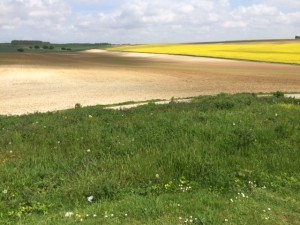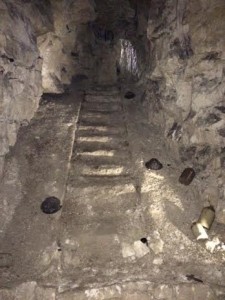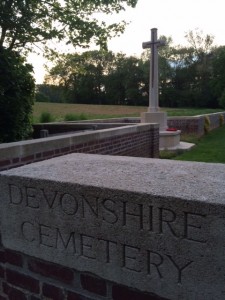After an informative and emotional four days of studying the First World War, the focus of our tour switched to the Canadian contribution in the Second World War. As part of this shift we stood on the hills overlooking the coast of the French Channel Ports. Although picturesque today, save for the poor weather which finally greeted our group after a warm and sunny start to the tour, the landscape of the Channel Ports was once the site of hard-fought battles in which the Allies experienced “surprisingly tenacious” resistance on the part of the Germans. Capturing these objectives, which were held by the Germans until September 1944, was necessary for the Allies to supply their Eastward advance towards Germany (and in the process liberate Belgium and the Netherlands.) The task of doing so was entrusted to the Canadian Army. And a large portion of the Ports were entrusted to only the 3rd Canadian Infantry Division. Today we focused on those Ports which 3rd Division successfully took over the month of September 1944, albeit after enduring many obstacles and incurring high casualties. These were Boulogne, Cap Gris Nez and Calais.
However, the Germans constructed heavily fortified bunkers complete with strong gun batteries throughout these Port cities to maintain these crucial holdings. In September 1944 Hitler declared the German garrisons stationed in the Channel ports to hold their positions at all costs, designating the Ports as fortresses. Therefore, the bunkers are the physical representatives of the challenging objectives that the Canadians were expected to break through. Many of these bunkers have been preserved and our group was able to visit a number of them today. Standing on the landscape today and witnessing the fortifications established by the Germans, it is easy to understand the necessity of the Channel Ports, but most importantly, what a task it must have been to break through the German defences to secure them.
Contemporary and modern memory of the mission to capture the Channel Ports remains conflicted. Both during the war and into today it continues to be questioned whether the mission to capture the Channel Ports was a worthwhile one. The British were quick to criticize the slowness of the Canadians to capture the three ports, which they considered to be minor tasks that could each be taken within a day. Others have suggested that by the time the Channel Ports actually became operational, ports further East such as Antwerp could have alternatively been used to supply the Allied advance. This latter criticism insinuates that the battle was more costly than strategically important. Despite these criticisms, I believe that the battles for Boulogne, Cap Gris Nez and Calais say much more about the preparedness, commitment and resourcefulness of the 3rd Canadian Infantry Division. Three Brigades of 3rd Division managed to take three ports and capture 30,000 German soldiers with fewer in each subsequent battle than the one before.
Being able to put the battles into physical perspective by reading the land itself as a primary source and viewing remnants of the German defenses, I was able to gain a much greater appreciation for the hard-fought efforts of Canadian soldiers. This has been my experience on the tour thus far and I look forward to gaining a greater comprehension of the geography and obstacles that Canadian and other Allied soldiers were forced to combat during the Two World Wars.
Rachael Ward




